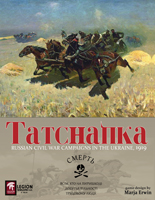|
Tatchanka!
Russian Civil War Campaigns
Ukraine, 1919
by Marja Erwin

|
Tatchanka
Includes two games that cover two decisive moments when independent forces could have changed the course of the Russian Civil War.
Fall of the Directory starts with the Ukrainian Directory at its strongest. The Directory control most of Ukraine, but its army has been divided by the defeat of Skoropadski, and the policy divisions between Vinnichenko and Petliura. The Bolsheviks and Volunteers are positioned to invade Ukraine and fight each other for the Donets Basin.
Historically, the Ukrainian People's Army outnumbered the Ukrainian Red Army, but the Red Army defeated the People's Army in detail, capturing Kharkiv, Katerynoslav, and Kiiv. If the People's Army had held central Ukraine and rebuilt its forces, the Directory might have held onto independence, like the Baltic states.
Makhno's Return starts with the Armed Forces of South Russia at their most successful. The Armed Forces of South Russia thinly-stretched forces occupied most of Ukraine, but the Revolutionary Insurrectionary Army of Ukraine threatens to break through the White screen and seize important cities in the White rear area.
Historically, the Revolutionary Insurrectionary Army of Ukraine seized Oleksandrivsk, Berdiansk, Taganrog, and Katerynoslav, and mustered tens of thousands of fighting troops, but the Armed Forces of South Russia eventually retook all these cities, and the Revolutionary Insurrectionary Army suffered large-scale desertion during the winter and the typhus epidemic. If the Revolutionary Insurrectionary Army had held onto one of the major cities, it might have retained its strength, and protected the Free Soviets in Ukraine.
Scope
The Civil War in Ukraine was closely linked with the Civil War in central and southern Russia. It allows three main design approaches, but few opportunities for compromise.
A first approach is to cover the entire theater, including the Ukrainian, Southern and later Southeastern Fronts against the Armed Forces of South Russia. But the main fighting occurs between Rostov, Tula, and potentially Moskva. Ukraine is only one front, and not always the critical front. This approach tends to reduce the Makhnovists and the Directory to minor allies of the Bolsheviks and usually the Whites, respectively.
A second approach is to focus on Ukraine. This approach works well when the fighting in Ukraine is separate from the fighting in Russia, which it is in Fall of the Directory and Makhno's Return. This falls apart when the fronts are linked together, which they were between the two games.
An alternative approach would have been to focus on the conflicts between opposing political movements, beginning before the October Revolution and with the Left and Right Social Revolutionaries, the Bolsheviks, the Pro-German and anti-German Whites, and other factions would oppose each other. The political and ecoomic concerns would require more attention and the military ones could be abstracted.
I think each of these approaches has its merits, but this game can only use one. I experimented with the first approach, but decided on the second.
Scale
The unit scale reflects the ability of small forces, as few as 1,500 to 2,500 combat troops, to operate independently. At key moments in July and August 1919, the 3rd Rifle Division of the Ukrainian People's Army, operated independently, and blocked key rail lines; in September and October 1919, Rosenschild-Paulin's Detachment of the Armed Forces of South Russia held the left flank of the Forces of the Novorossiysk Region. A unit scale of about 2,000 combat troops per unit allows the players to detach similarly-sized forces of one unit, or sometimes two units, if and when needed.
The map and time scales reflect the campaigns the games focus on, the areas they covered, and the time they lasted. Although divisions and brigades had doctrinal frontages of several versts, they were often required to deploy their regiments and battalions along far longer fronts, or to separate outposts. A map scale significantly more detailed than 32 versts (20 miles) per hex would leave too little room for either campaign.
* For those unfamiliar with the term, "tatchanka" refers to a horse-drawn fighting vehicle, usually a cart or an open wagon with a stationary heavy machine gun (or "maxim") installed in the back. It had a crew of 2 or 3 (one driver and a gun crew). Nestor Makhno pioneered the use of the tatchanka in a mass charge. A large number of the vehicles would assault the enemy position as if they were cavalry, then wheel in a coordinated manoeuvre so that all at once suddenly had their muzzles to the enemy, and fire a point-blank burst of machine gun fire, all of it going into the same point of the enemy line. This manoeuvre required very precise coordination between the crews, but Makhno was good enough to make it work, using it to win a battle with Deniken's forces in 1919.
|

